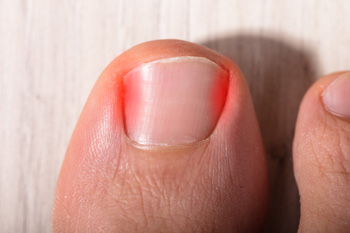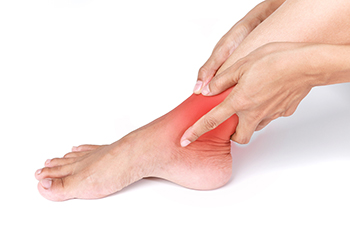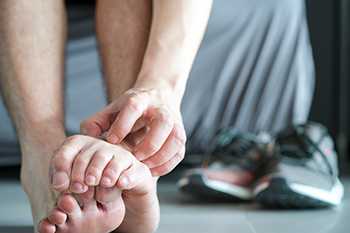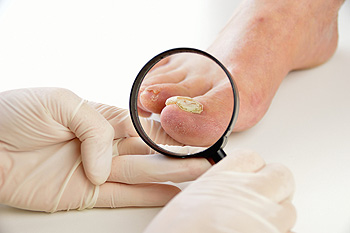Items filtered by date: October 2023
Painful Ingrown Toenails

Ingrown toenails, a common foot ailment, occur when the toenail's edge grows into the surrounding skin, often causing pain, redness, and swelling. This condition can affect any toe but is most frequently seen on the big toe. The causes of ingrown toenails are diverse, typically stemming from improper nail trimming, where cutting the nail too short or rounding its edges can encourage it to grow into the skin. Wearing ill-fitting shoes that compress the toes or trauma to the nail can also trigger ingrowth. Additionally, some individuals may have a genetic predisposition to ingrown toenails due to the natural shape of their nails. Hygiene also plays a role, as fungal infections can thicken the nail, making it more likely to become ingrown. If not addressed promptly, ingrown toenails can lead to infections, making early care essential for foot health. If you have developed an ingrown toenail, it is strongly suggested that you are under the care of a podiatrist who can effectively treat this condition.
Ingrown toenails can become painful if they are not treated properly. For more information about ingrown toenails, contact one of our podiatrists of Toe-tal Family Footcare Associates. Our doctors can provide the care you need to keep you pain-free and on your feet.
Ingrown Toenails
Ingrown toenails occur when a toenail grows sideways into the bed of the nail, causing pain, swelling, and possibly infection.
Causes
- Bacterial infections
- Improper nail cutting such as cutting it too short or not straight across
- Trauma to the toe, such as stubbing, which causes the nail to grow back irregularly
- Ill-fitting shoes that bunch the toes too close together
- Genetic predisposition
Prevention
Because ingrown toenails are not something found outside of shoe-wearing cultures, going barefoot as often as possible will decrease the likeliness of developing ingrown toenails. Wearing proper fitting shoes and using proper cutting techniques will also help decrease your risk of developing ingrown toenails.
Treatment
Ingrown toenails are a very treatable foot condition. In minor cases, soaking the affected area in salt or antibacterial soaps will not only help with the ingrown nail itself, but also help prevent any infections from occurring. In more severe cases, surgery is an option. In either case, speaking to your podiatrist about this condition will help you get a better understanding of specific treatment options that are right for you.
If you have any questions please feel free to contact our office located in Vista, CA and Las Vegas, NV . We offer the newest diagnostic and treatment technologies for all your foot and ankle needs.
Risk Factors and Symptoms of Ankle Gout

Gout is a painful form of inflammatory arthritis that can affect various joints in the body, usually the big toe. When it strikes the ankle, it's referred to as ankle gout. This condition can be identified by sudden and intense pain, swelling, and redness in the affected joint. The root cause of gout in the ankle is a buildup of uric acid. This waste product is produced during the breakdown of purines, which are found in certain foods, like red meat and seafood. Normally, your body transports uric acid to the kidneys for elimination in urine. But if not properly flushed out, excessive uric acid remains in the bloodstream, termed hyperuricemia. Eventually, uric acid crystals can accumulate in certain joints, including the ankle joint, and cause the classic symptoms of pain, swelling, and redness. Gout flares usually peak within 12 to 24 hours of onset and gradually improve over one to two weeks, with or without treatment. Some individuals may experience only one gout flare in their lifetime, while others suffer from recurring flares. In cases of recurring gout flares, symptoms can become more severe and prolonged, potentially leading to joint damage. If you suspect you have ankle gout, it is suggested that you make an appointment with a podiatrist for a proper diagnosis and more advanced treatment options.
Gout is a foot condition that requires certain treatment and care. If you are seeking treatment, contact one of our podiatrists from Toe-tal Family Footcare Associates. Our doctors will treat your foot and ankle needs.
What Is Gout?
Gout is a type of arthritis caused by a buildup of uric acid in the bloodstream. It often develops in the foot, especially the big toe area, although it can manifest in other parts of the body as well. Gout can make walking and standing very painful and is especially common in diabetics and the obese.
People typically get gout because of a poor diet. Genetic predisposition is also a factor. The children of parents who have had gout frequently have a chance of developing it themselves.
Gout can easily be identified by redness and inflammation of the big toe and the surrounding areas of the foot. Other symptoms include extreme fatigue, joint pain, and running high fevers. Sometimes corticosteroid drugs can be prescribed to treat gout, but the best way to combat this disease is to get more exercise and eat a better diet.
If you have any questions please feel free to contact our office located in Vista, CA and Las Vegas, NV . We offer the newest diagnostic and treatment technologies for all your foot and ankle needs.
Identifying Symptoms and Root Causes of Athlete’s Foot

Athlete's foot, a common fungal infection, can cause discomfort and frustration for those affected. The symptoms often include itching, burning, and stinging sensations in the affected areas, generally between the toes or on the soles of the feet. Skin peeling, blistering, and dryness may also occur. This condition is primarily caused by various types of fungi, thriving in warm, damp environments such as locker rooms, swimming pools, and shared showers. Direct contact with the fungi through contaminated surfaces or by sharing shoes, towels, or socks can facilitate its spread. Additionally, individuals with sweaty feet or those who wear tight, closed toe shoes for extended periods are at higher risk. Maintaining proper foot hygiene, wearing breathable footwear, and keeping feet dry can aid in prevention and mitigate the symptoms of athlete's foot. Athlete’s foot is treated by a podiatrist, and it is suggested that you visit this type of doctor who can effectively treat this condition.
Athlete’s foot is an inconvenient condition that can be easily reduced with the proper treatment. If you have any concerns about your feet and ankles, contact one of our podiatrists from Toe-tal Family Footcare Associates. Our doctors will treat your foot and ankle needs.
Athlete’s Foot: The Sole Story
Athlete's foot, also known as tinea pedis, can be an extremely contagious foot infection. It is commonly contracted in public changing areas and bathrooms, dormitory style living quarters, around locker rooms and public swimming pools, or anywhere your feet often come into contact with other people.
Solutions to Combat Athlete’s Foot
- Hydrate your feet by using lotion
- Exfoliate
- Buff off nails
- Use of anti-fungal products
- Examine your feet and visit your doctor if any suspicious blisters or cuts develop
Athlete’s foot can cause many irritating symptoms such as dry and flaking skin, itching, and redness. Some more severe symptoms can include bleeding and cracked skin, intense itching and burning, and even pain when walking. In the worst cases, Athlete’s foot can cause blistering as well. Speak to your podiatrist for a better understanding of the different causes of Athlete’s foot, as well as help in determining which treatment options are best for you.
If you have any questions please feel free to contact our office located in Vista, CA and Las Vegas, NV . We offer the newest diagnostic and treatment technologies for all your foot and ankle needs.
Causes and Symptoms of Toenail Fungus

Toenail fungus, known as onychomycosis, is a common condition that results from exposure to an overgrowth of certain fungi in your toenails. These fungi, including dermatophytes and yeast, can be found naturally on the skin or in the environment, possibly as airborne spores. A contributing factor to toenail fungus is a warm and humid environment that promotes fungal growth. If your feet remain damp or sweaty for extended periods, these microbes can thrive and rapidly multiply, leading to an infection. Moreover, any crack or tear in the skin or nail can provide an entry point for the fungi, allowing them to penetrate deeper into the tissue. As the infection progresses, fungal debris accumulates under the nail, causing it to thicken and change color, typically turning yellow, brown, or white. Cracks may develop in the affected nail as it weakens. This infection can become progressively severe if left untreated. Recognizing the common symptoms early and seeking prompt treatment from a podiatrist is essential. If you believe you have toenail fungus, it is suggested that you seek the help of a podiatrist as quickly as possible.
If left untreated, toenail fungus may spread to other toenails, skin, or even fingernails. If you suspect you have toenail fungus it is important to seek treatment right away. For more information about treatment, contact one of our podiatrists of Toe-tal Family Footcare Associates. Our doctors can provide the care you need to keep you pain-free and on your feet.
Symptoms
- Warped or oddly shaped nails
- Yellowish nails
- Loose/separated nail
- Buildup of bits and pieces of nail fragments under the nail
- Brittle, broken, thickened nail
Treatment
If self-care strategies and over-the-counter medications does not help your fungus, your podiatrist may give you a prescription drug instead. Even if you find relief from your toenail fungus symptoms, you may experience a repeat infection in the future.
Prevention
In order to prevent getting toenail fungus in the future, you should always make sure to wash your feet with soap and water. After washing, it is important to dry your feet thoroughly especially in between the toes. When trimming your toenails, be sure to trim straight across instead of in a rounded shape. It is crucial not to cover up discolored nails with nail polish because that will prevent your nail from being able to “breathe”.
In some cases, surgical procedure may be needed to remove the toenail fungus. Consult with your podiatrist about the best treatment options for your case of toenail fungus.
If you have any questions, please feel free to contact our office located in Vista, CA and Las Vegas, NV . We offer the newest diagnostic and treatment technologies for all your foot care needs.
Ballerina Feet

Ballet, especially when practicing the pointe technique, can lead to foot pain, injuries, and potential long-term damage. Pointe shoes, made with dense materials, support a dancer's body weight on fully extended feet, making it a challenging form of dance for the feet. Common foot injuries among ballet dancers include blisters, ingrown toenails, and sprained ankles. Bunions and stress fractures may also affect ballet dancers. These injuries can result from intense training and repetitive movements. Dancers typically transition to pointe shoes between ages 11 and 13, after their foot bones have ossified or hardened. Male ballet dancers, who do more lifting and jumping, are also susceptible to foot issues, such as Achilles tendonitis and sprained ankles. Continuing to dance with untreated foot injuries can lead to permanent damage, especially for professional dancers who spend extended periods on pointe. Some injuries, if left untreated, may require surgical intervention. Treatment for dance-related foot injuries varies depending on the cause and severity. If you are a dancer or your child is starting to dance, it is suggested that you make an appointment with a podiatrist to understand how to take care of the feet best to prevent long-term consequences of participating in this activity.
Sports related foot and ankle injuries require proper treatment before players can go back to their regular routines. For more information, contact one of our podiatrists of Toe-tal Family Footcare Associates. Our doctors can provide the care you need to keep you pain-free and on your feet.
Sports Related Foot and Ankle Injuries
Foot and ankle injuries are a common occurrence when it comes to athletes of any sport. While many athletes dismiss the initial aches and pains, the truth is that ignoring potential foot and ankle injuries can lead to serious problems. As athletes continue to place pressure and strain the area further, a mild injury can turn into something as serious as a rupture and may lead to a permanent disability. There are many factors that contribute to sports related foot and ankle injuries, which include failure to warm up properly, not providing support or wearing bad footwear. Common injuries and conditions athletes face, including:
- Plantar Fasciitis
- Plantar Fasciosis
- Achilles Tendinitis
- Achilles Tendon Rupture
- Ankle Sprains
Sports related injuries are commonly treated using the RICE method. This includes rest, applying ice to the injured area, compression and elevating the ankle. More serious sprains and injuries may require surgery, which could include arthroscopic and reconstructive surgery. Rehabilitation and therapy may also be required in order to get any recovering athlete to become fully functional again. Any unusual aches and pains an athlete sustains must be evaluated by a licensed, reputable medical professional.
If you have any questions please feel free to contact our office located in Vista, CA and Las Vegas, NV . We offer the newest diagnostic and treatment technologies for all your foot and ankle needs.